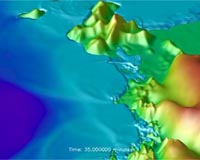| . |  |
. |
Washington (AFP) Feb 27, 2010 Hawaii was placed on tsunami alert early Saturday after a giant earthquake struck Chile triggering warnings that emergency action should be taken as all its the islands could face damage. "A tsunami has been generated that could cause damage along coastlines of all islands in the state of Hawaii," the Pacific Tsunami Warning Center said. "Urgent action should be taken to protect lives and property," the Hawaii-based center added. It warned the first waves could hit at 11:19 am in Hawaii (2119 GMT), and said a tsunami consisted of a long series of ocean waves, with each wave able to last five to 15 minutes. The center added in its statement that wave heights cannot be predicted and the first wave to hit the coastal ares might not be the highest. Such waves can cause extensive flooding to low-lying areas. "All shores are at risk no matter which direction they face. The trough of a tsunami wave may temporarily expose the seafloor but the area will quickly flood again," the statement said. "Extremely strong and unusual nearshore currents can accompany a tsunami. Debris picked up and carried by a tsunami amplifies its destructive power. "Simultaneous high tides or high surf can significantly increase the tsunami hazard." The 8.8 quake that struck central Chile early Saturday triggered a tsunami warning across the volatile Pacific rim of fire stretching from Japan to the Antarctic.
earlier related report The Pacific Tsunami Warning Center warned dozens of far-flung islands and atolls of possible "widespread damage" from waves generated by the 8.8-magnitude earthquake in Chile, which killed at least 78 people. "Sea level readings confirm that a tsunami has been generated which could cause widespread damage," the Hawaii-based center said. "Authorities should take appropriate action in response to this threat." Despite their great distance from the quake zone, at-risk nations included New Zealand, Australia, Japan, the Philippines and a string of Pacific archipelagos including Tonga and Samoa. Chile's remote Robinson Crusoe Island, some 700 kilometres (430 miles) from the mainland, was smashed by a huge wave after the quake, while President Michelle Bachelet also announced a partial evacuation of Easter Island. New Zealand warned of a wall of water up to three metres (9.8 feet) high potentially hitting outlying islands and part of the South Island, as the country's National Crisis Management Centre went on alert. The civil defence ministry said the tsunami could hit the country's east coast from 7:05 am (1805 GMT Saturday). The Joint Australian Tsunami Warning Centre warned of the "possibility of dangerous waves, strong ocean currents and foreshore flooding" along the coast between Sydney and Brisbane. Officials in the Philippines started planning for possible evacuations. "No evacuation order is in effect but communities along the east coast of the country are advised to wait for further information and to prepare for possible evacuation," the Philippine Institute of Volcanology and Seismology said. "Coastal areas fronting the Pacific Ocean... should keep watch." Jake Phillips, a forecaster with Australia's Bureau of Meteorology, played down the risk of major flooding in heavily populated coastal areas. "But there is a marine threat and that would include anyone out boating or rock fishermen," he said. Coastal residents were urged to stay away from the shoreline, while any boats should be taken back to harbour and strongly secured. Memories are still raw in Samoa, American Samoa and Tonga of a terrifying tsunami that trashed entire villages in September, leaving 184 dead and sparking a major international relief operation. Just a week later, thousands fled South Pacific coastal areas after a rapid succession of powerful earthquakes off Vanuatu. The Pacific "Ring of Fire" region is often hit by seismic activity caused by massive tectonic movement. The latest warnings evoked memories of the 2004 Boxing Day tsunami which killed more than 220,000 people around the Indian Ocean. That was on the other side of Asia, but Pacific nations subsequently stepped up their own tsunami preparations in concert with the US government, with a system of electronic buoys in place to give real-time warning of giant waves. Australian officials said any tsunami would not be seen for several hours with effects only visible from about 8:15 am on Sunday (2115 GMT Saturday). If generated, a tsunami would reach the east coast of Japan around noon Sunday (0300 GMT Sunday), according to the country's meteorological agency. "We would like people to be fully on alert for related information," agency official Yasuo Sekita told a hastily arranged news conference, as Prime Minister Yukio Hatoyama ordered his government to be ready for relief work. There were no tsunami alerts immediately issued in Indonesia and Taiwan, but officials said they were monitoring closely.
Share This Article With Planet Earth
Related Links Bringing Order To A World Of Disasters When the Earth Quakes A world of storm and tempest
 Tsunami-generating quake possible off Indonesia: scientists
Tsunami-generating quake possible off Indonesia: scientistsParis (AFP) Jan 17, 2010 A huge wave-generating quake capable of killing as many people as in the 2004 Indian Ocean tsunami could strike off the Indonesian island of Sumatra, and the city of Padang is in the firing line, a team of seismologists said on Sunday. The group -- led by a prominent scientist who predicted a 2005 Sumatran quake with uncanny accuracy -- issued the warning in a letter to the journal Nature Ge ... read more |
|
| The content herein, unless otherwise known to be public domain, are Copyright 1995-2010 - SpaceDaily. AFP and UPI Wire Stories are copyright Agence France-Presse and United Press International. ESA Portal Reports are copyright European Space Agency. All NASA sourced material is public domain. Additional copyrights may apply in whole or part to other bona fide parties. Advertising does not imply endorsement,agreement or approval of any opinions, statements or information provided by SpaceDaily on any Web page published or hosted by SpaceDaily. Privacy Statement |